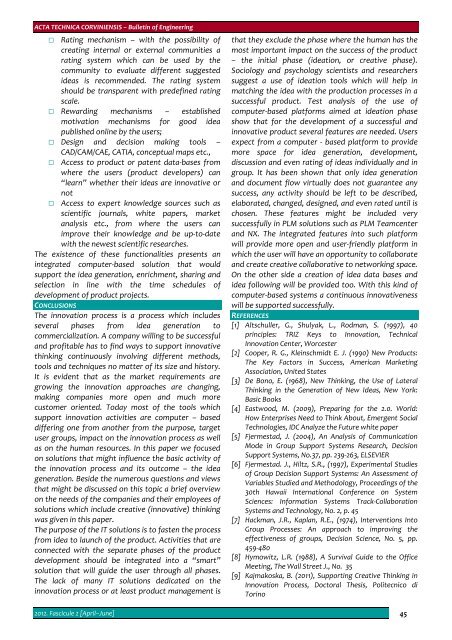Editorial & Advisory Board - Acta Technica Corviniensis
Editorial & Advisory Board - Acta Technica Corviniensis
Editorial & Advisory Board - Acta Technica Corviniensis
Create successful ePaper yourself
Turn your PDF publications into a flip-book with our unique Google optimized e-Paper software.
ACTA TECHNICA CORVINIENSIS – Bulletin of Engineering<br />
Rating mechanism – with the possibility of<br />
creating internal or external communities a<br />
rating system which can be used by the<br />
community to evaluate different suggested<br />
ideas is recommended. The rating system<br />
should be transparent with predefined rating<br />
scale.<br />
Rewarding mechanisms – established<br />
motivation mechanisms for good idea<br />
published online by the users;<br />
Design and decision making tools –<br />
CAD/CAM/CAE, CATIA, conceptual maps etc.,<br />
Access to product or patent data‐bases from<br />
where the users (product developers) can<br />
“learn” whether their ideas are innovative or<br />
not<br />
<br />
Access to expert knowledge sources such as<br />
scientific journals, white papers, market<br />
analysis etc., from where the users can<br />
improve their knowledge and be up‐to‐date<br />
with the newest scientific researches.<br />
The existence of these functionalities presents an<br />
integrated computer‐based solution that would<br />
support the idea generation, enrichment, sharing and<br />
selection in line with the time schedules of<br />
development of product projects.<br />
CONCLUSIONS<br />
The innovation process is a process which includes<br />
several phases from idea generation to<br />
commercialization. A company willing to be successful<br />
and profitable has to find ways to support innovative<br />
thinking continuously involving different methods,<br />
tools and techniques no matter of its size and history.<br />
It is evident that as the market requirements are<br />
growing the innovation approaches are changing,<br />
making companies more open and much more<br />
customer oriented. Today most of the tools which<br />
support innovation activities are computer – based<br />
differing one from another from the purpose, target<br />
user groups, impact on the innovation process as well<br />
as on the human resources. In this paper we focused<br />
on solutions that might influence the basic activity of<br />
the innovation process and its outcome – the idea<br />
generation. Beside the numerous questions and views<br />
that might be discussed on this topic a brief overview<br />
on the needs of the companies and their employees of<br />
solutions which include creative (innovative) thinking<br />
was given in this paper.<br />
The purpose of the IT solutions is to fasten the process<br />
from idea to launch of the product. Activities that are<br />
connected with the separate phases of the product<br />
development should be integrated into a “smart”<br />
solution that will guide the user through all phases.<br />
The lack of many IT solutions dedicated on the<br />
innovation process or at least product management is<br />
that they exclude the phase where the human has the<br />
most important impact on the success of the product<br />
– the initial phase (ideation, or creative phase).<br />
Sociology and psychology scientists and researchers<br />
suggest a use of ideation tools which will help in<br />
matching the idea with the production processes in a<br />
successful product. Test analysis of the use of<br />
computer‐based platforms aimed at ideation phase<br />
show that for the development of a successful and<br />
innovative product several features are needed. Users<br />
expect from a computer ‐ based platform to provide<br />
more space for idea generation, development,<br />
discussion and even rating of ideas individually and in<br />
group. It has been shown that only idea generation<br />
and document flow virtually does not guarantee any<br />
success, any activity should be left to be described,<br />
elaborated, changed, designed, and even rated until is<br />
chosen. These features might be included very<br />
successfully in PLM solutions such as PLM Teamcenter<br />
and NX. The integrated features into such platform<br />
will provide more open and user‐friendly platform in<br />
which the user will have an opportunity to collaborate<br />
and create creative collaborative to networking space.<br />
On the other side a creation of idea data bases and<br />
idea following will be provided too. With this kind of<br />
computer‐based systems a continuous innovativeness<br />
will be supported successfully.<br />
REFERENCES<br />
[1] Altschuller, G., Shulyak, L., Rodman, S. (1997), 40<br />
principles: TRIZ Keys to Innovation, <strong>Technica</strong>l<br />
Innovation Center, Worcester<br />
[2] Cooper, R. G., Kleinschmidt E. J. (1990) New Products:<br />
The Key Factors in Success, American Marketing<br />
Association, United States<br />
[3] De Bono, E. (1968), New Thinking, the Use of Lateral<br />
Thinking in the Generation of New Ideas, New York:<br />
Basic Books<br />
[4] Eastwood, M. (2009), Preparing for the 2.0. World:<br />
How Enterprises Need to Think About, Emergent Social<br />
Technologies, IDC Analyze the Future white paper<br />
[5] Fjermestad, J. (2004), An Analysis of Communication<br />
Mode in Group Support Systems Research, Decision<br />
Support Systems, No.37, pp. 239‐263, ELSEVIER<br />
[6] Fjermestad. J., Hiltz, S.R., (1997), Experimental Studies<br />
of Group Decision Support Systems: An Assessment of<br />
Variables Studied and Methodology, Proceedings of the<br />
30th Hawaii International Conference on System<br />
Sciences: Information Systems Track‐Collaboration<br />
Systems and Technology, No. 2, p. 45<br />
[7] Hackman, J.R., Kaplan, R.E., (1974), Interventions Into<br />
Group Processes: An approach to improving the<br />
effectiveness of groups, Decision Science, No. 5, pp.<br />
459‐480<br />
[8] Hymowitz, L.R. (1988), A Survival Guide to the Office<br />
Meeting, The Wall Street J., No. 35<br />
[9] Kajmakoska, B. (2011), Supporting Creative Thinking in<br />
Innovation Process, Doctoral Thesis, Politecnico di<br />
Torino<br />
2012. Fascicule 2 [April–June] 45

















